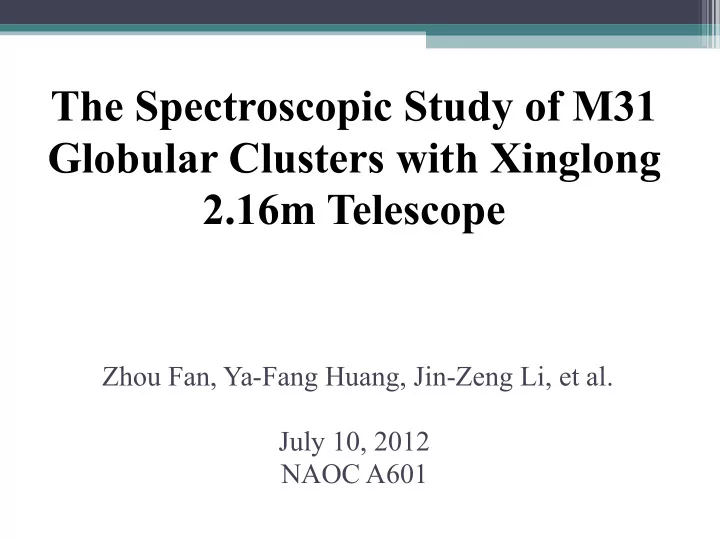

The Spectroscopic Study of M31 Globular Clusters with Xinglong 2.16m Telescope Zhou Fan, Ya-Fang Huang, Jin-Zeng Li, et al. July 10, 2012 NAOC A601
Descriptions of Globular Clusters 1. They are densely packed, gravitationally bound spherical systems containing several thousands to approximately one million stars; 2. They formed at the very beginning of the host galaxy and it provides improtant information of the galaxy formation and evolution; 3. Simple stellar population, single age, single abundance; 4. It is compact and luminous, which can be probed in the extragalaxies. (Coma cluster GCs, d=108 Mpc, z=0.023). M31GC -- G1
Andromeda (M31) Located at a distance of ~780 kpc, M31 is the nearest and largest spiral galaxy in our Local Group. It contains >700 GCs and is considered an ideal laboratory for studies of star clusters in external galaxies. NGC205 M32
Metallicity as a funtion of distance from M31 center Perrett et al. (2002) Fan et al. (2008) Metal-rich clusters: b=0.000±0.001 Metal-poor clusters: b=-0.006±0.001 This gradient in the metal-poor clusters is not inconsistent with a single collapse scenario, yet we recognize that a metallicity gradient, is not sufficient to confirm an early dissipational collapse. Such a gradient could be mimicked by a hierarchical halo formation if the metallicity of the accreting fragments correlates with their mass and mean density.
Dose the radial metallicity gradient still exist for a larger distance from the galaxy center?
The observations of 2010 1. Observations: Sep 10-13, 2010 2. Facility: An OMR spectrograph and a PI 1340×400 CCD detector were used during this run with a dispersion of 200 A ̊ mm−1, 4.8 A ̊ pixel−1, and a 3.0 ′′slit. 3. Exposure: of 3 × 1800 seconds were taken with seeing typically ∼ 2.5 ′′. 4. Our spectra cover the wavelength range of 3500 − 8100 A ̊ at 4 A ̊ resolution. 5. All our spectra have S/N ≥ 40.
Lick indices and spectrum of B023
SSP model 1.Thomas et al. (2003) provided stellar population models including Lick absorption line indices for various elemental-abundance ratios, covering ages from 1 to 15 Gyr and metallicities from 1/200 to 3.5× solar abundance. 2.These models are based on the standard models of Maraston (1998), with input stellar evolutionary tracks from Cassisi et al. (1997) and Bono et al. (1997) and a Salpeter (1955) stellar initial mass function. 3.The latest stellar population model for Lick absorption-line indices (Thomas et al., 2010) is an improvement on Thomas et al. (2003) and Thomas et al. (2004). They were derived from the MILES stellar library, which provides a higher spectral resolution appropriate for MILES and SDSS spectroscopy, as well as flux calibration. 4.The models cover ages from 0.1 to 15 Gyr, [Z/H] from � 2.25 to 0.67 dex, and [� /Fe] from � 0.3 to 0.5 dex.
The Metallicity Gradient We found the metallicity gradient for all the confirmed clusters exists with a slope of −0.028 ± 0.001 dex kpc −1 . However, the slope turns to be −0.018 ± 0.001 dex kpc −1 for all the halo clusters
Outer Halo Clusters The slope k= −0.010 ± 0.002 dex kpc −1 and if one cluster G001 is excluded from the outer halo sample, k= −0.004 ± 0.002 dex kpc −1
Vr Vs. distance along major axis (X)
The observations of 2011 1. Observations: from Aug 28 to Sep1, 2011 2. Facility: An OMR spectrograph and a PI 1340×400 CCD detector were used during this run with a dispersion of 200 A ̊ mm−1, 4.8 A ̊ pixel−1, and a 3.0 ′′slit. 3. Exposure: of 3 × 1800 seconds were taken with seeing typically ∼ 2.5 ′′. 4. Our spectra cover the wavelength range of 3500 − 8100 A ̊ at 4 A ̊ resolution. 5. All our spectra have S/N ≥ 40.
Outer Halo Clusters The slope of the linear fitting is −0.005 ± 0.005 dex kpc−1 (black solid line). However, if the two highest metallicity GCs G001 and H11 are excluded, the slope turns out to be −0.002 ± 0.003 dex kpc −1
Metallicity Vs. age
Spatial Distributions
Publications 1.Fan, Zhou; Huang, Ya-Fang; Li, Jin-Zeng; Zhou, Xu; Ma, Jun; Zhao, Yong-Heng, 2012, RAA, 12,829, “Spectroscopic study of globular clusters in the halo of M31 with the Xinglong 2.16 m telescope II: dynamics, metallicity and age” 2.Fan, Zhou; Huang, Ya-Fang; Li, Jin-Zeng; Zhou, Xu; Ma, Jun; Wu, Hong; Zhang, Tian-Meng; Zhao, Yong-Heng, 2011, RAA, 11,1298, “Spectroscopic study of globular clusters in the halo of M31 with the Xinglong 2.16 m telescope”
Thanks a lot ! The work is supported by NFSC No.11003021 "Obervational Study on Formation and Evolution of Andromeda Galaxy" (PI: Fan Zhou, 2011-2013) Homepage: http://batc.bao.ac.cn/~fanzhou
Recommend
More recommend